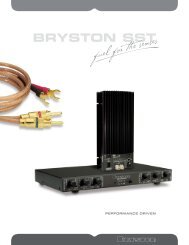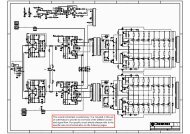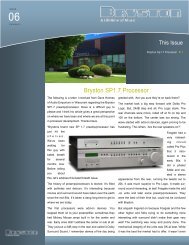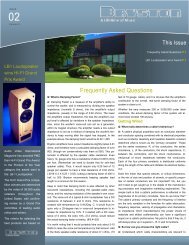Volume 3, Issue 1 - Bryston
Volume 3, Issue 1 - Bryston
Volume 3, Issue 1 - Bryston
You also want an ePaper? Increase the reach of your titles
YUMPU automatically turns print PDFs into web optimized ePapers that Google loves.
Urban Legend<br />
True Crime<br />
Rounders<br />
Lethal Weapon 4<br />
The Judas Kiss<br />
Dr Doolittle<br />
Long Island Incident<br />
My Giant<br />
Meet The Deedles<br />
Recent TV shows:<br />
Godzilla<br />
Lionhearts<br />
Hercules<br />
Robocop<br />
Thicker Than Blood<br />
The Rat Pack<br />
Earth to The Moon<br />
input, by a factor equal to its common-mode rejection<br />
ratio, (normally over 1000:1). A 'fully-balanced' circuit<br />
has a common-mode rejection ratio of precisely zero,<br />
since all signal, common-mode or not, is simply amplified<br />
and passed along via the two signal paths. It then<br />
remains up to the following component to attempt to<br />
reject that amplified noise, if it has a differential amplifier.<br />
Thus, fully-balanced circuitry is subject to passing<br />
along any noise which might be picked up on all the<br />
cables. Then it hits the final component in the system,<br />
usually the power amp, where the differential amplifier<br />
at its input is left to deal with the sum total of the common<br />
mode noise in the signal path, (multiplied by all<br />
the gain in the system).<br />
I don't think this is an ideal scenario. If each component,<br />
(source, preamp, electronic crossover, power<br />
amp), had its own differential amplifier input, it would<br />
cancel any common-mode noise which appeared<br />
ahead of it, rather than amplifying it.<br />
<strong>Bryston</strong> makes a product which operates in the fullybalanced<br />
mode a microphone preamp (BMP 2), but<br />
this unit has an input transformer which rejects common-mode<br />
noise by a factor of over 250,000:1. The<br />
reason it operates on two separate signal paths is to<br />
expand its dynamic range beyond what digital storage<br />
media can accommodate. Since the next step in the<br />
signal path is into digital storage media (CD, DVD etc.)<br />
from there, this separate signal path is obviously not a<br />
concern in any following signal-processing on its way<br />
to your living room, and your ears.<br />
All the above simply points out that what has been<br />
called fully balanced circuitry has a host of disadvantages<br />
from cost to noise overload. to complexity and<br />
reduction in reliability. It has no useful advantages in<br />
the digital or analog signal chain beyond the mic preamp.<br />
<strong>Bryston</strong> audio components with the exception of<br />
our BMP-2 mic preamp, all operate their balanced<br />
inputs on differential amplifier technology.<br />
<strong>Bryston</strong> Ltd.<br />
677 Neal Drive<br />
Peterborough, Ontario<br />
CANADA<br />
K9J 6X7<br />
Phone: 705-742-5325 or 1-800-632-8217<br />
Fax: 705-742-0882<br />
Email: contact@bryston.com<br />
Web: http://www.bryston.com<br />
Editor: James Tanner, Vice President of Sales and Marketing<br />
Email: jamestanner@bryston.com

















